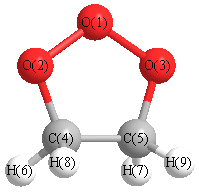Vibrational Frequencies calculated at CCSD/aug-cc-pVDZ
| Mode Number |
Symmetry |
Frequency
(cm-1) |
Scaled Frequency
(cm-1) |
IR Intensities
(km mol-1) |
Raman Act
(Å4/u) |
Dep P |
Dep U |
|---|
| 1 |
A' |
3164 |
3049 |
26.49 |
|
|
|
| 2 |
A' |
3086 |
2973 |
48.05 |
|
|
|
| 3 |
A' |
1518 |
1462 |
0.18 |
|
|
|
| 4 |
A' |
1354 |
1304 |
0.01 |
|
|
|
| 5 |
A' |
1243 |
1198 |
2.50 |
|
|
|
| 6 |
A' |
1031 |
994 |
27.73 |
|
|
|
| 7 |
A' |
959 |
924 |
16.82 |
|
|
|
| 8 |
A' |
904 |
871 |
3.20 |
|
|
|
| 9 |
A' |
863 |
831 |
0.58 |
|
|
|
| 10 |
A' |
708 |
682 |
1.46 |
|
|
|
| 11 |
A' |
416 |
401 |
3.94 |
|
|
|
| 12 |
A" |
3145 |
3030 |
0.44 |
|
|
|
| 13 |
A" |
3074 |
2961 |
19.55 |
|
|
|
| 14 |
A" |
1499 |
1444 |
0.50 |
|
|
|
| 15 |
A" |
1348 |
1299 |
1.16 |
|
|
|
| 16 |
A" |
1229 |
1184 |
0.02 |
|
|
|
| 17 |
A" |
1154 |
1112 |
0.08 |
|
|
|
| 18 |
A" |
1032 |
994 |
2.03 |
|
|
|
| 19 |
A" |
768 |
740 |
36.51 |
|
|
|
| 20 |
A" |
724 |
697 |
0.01 |
|
|
|
| 21 |
A" |
125 |
120 |
3.06 |
|
|
|
Unscaled Zero Point Vibrational Energy (zpe) 14671.1 cm
-1
Scaled (by 0.9634) Zero Point Vibrational Energy (zpe) 14134.2 cm
-1
See section
III.C.1 List or set vibrational scaling factors
to change the scale factors used here.
See section
III.C.2
Calculate a vibrational scaling factor for a given set of molecules
to determine the least squares best scaling factor.
